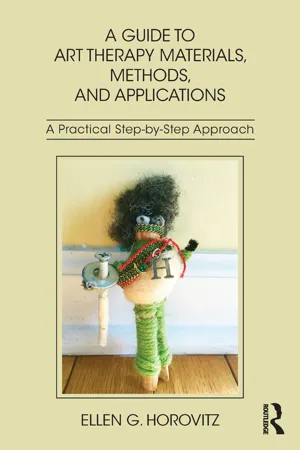
A Guide to Art Therapy Materials, Methods, and Applications
A Practical Step-by-Step Approach
- 190 pages
- English
- ePUB (mobile friendly)
- Available on iOS & Android
A Guide to Art Therapy Materials, Methods, and Applications
A Practical Step-by-Step Approach
About this book
Written by a well-respected author and practitioner in the field of art therapy, A Guide to Art Therapy Materials, Methods, and Applications is an innovative, comprehensive text that guides readers in how to use basic to advanced art materials and methods in a wide range of clinical settings. Through the lens of both developmental stages and assessment, the book offers practical, step-by-step instructions to incorporate these materials and methods into therapeutic work with clients of all ages and populations. In addition to such classic tools as drawing, paints, pastels, and clay, coverage of materials and special topics extends beyond the existing literature to include glass, knitting, quilting, wood burning, felting, digital applications, phototherapy, byproducts, and more. Unlike previous guides, this book specifies population benefits and contraindications for each material and technique. This research-based guide for using art materials in a safe and effective manner will be a welcome resource for students, seasoned art therapists, and mental health counselors.
Frequently asked questions
- Essential is ideal for learners and professionals who enjoy exploring a wide range of subjects. Access the Essential Library with 800,000+ trusted titles and best-sellers across business, personal growth, and the humanities. Includes unlimited reading time and Standard Read Aloud voice.
- Complete: Perfect for advanced learners and researchers needing full, unrestricted access. Unlock 1.4M+ books across hundreds of subjects, including academic and specialized titles. The Complete Plan also includes advanced features like Premium Read Aloud and Research Assistant.
Please note we cannot support devices running on iOS 13 and Android 7 or earlier. Learn more about using the app.
Information
1 Considerations on Safety and Art Materials
Regulation of Art Materials
Consumer Protection
Considerations When Working with Children’s Arts and Crafts
Types of Hazards
Mechanical Hazards: Strains, Breaks, Cuts, Crush Injuries, and Burns
Chemical Hazards: Inhalation, Skin Absorption, and Ingestion

Table of contents
- Cover
- Half Title
- Title Page
- Copyright Page
- Dedication
- Table of Contents
- About the Author
- Preface
- Acknowledgements
- 1 Considerations on Safety and Art Materials
- 2 Developmental Stages, Assessment, and Holistic Considerations
- 3 Basic Materials and Techniques: Strategies and Case Studies
- 4 Advanced Materials and Techniques: Strategies and Case Studies
- 5 Byproducts and Miscellaneous Applications
- Additional Resources
- Index